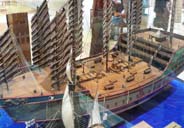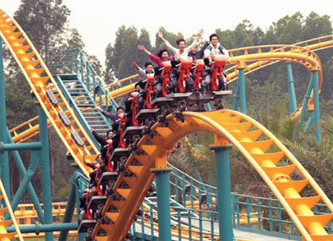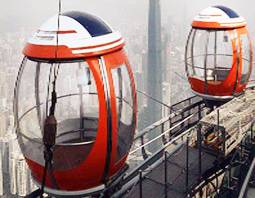100 SUNKEN TREASURES
WILL RETURN TO THE LIGHT |
 |
GuangZhou Hotels >>  In the next years will be recovered about 100 ancient shipwreck already localized in the South China Sea In the next years will be recovered about 100 ancient shipwreck already localized in the South China Sea
ANCIENT SHIPWRECK: THE SUNKEN TREASURES WILL RETURN TO THE LIGHT
Guangzhou was a fundamental landmark and a key port for the legendary "Maritime Silk Road". The majority of ships began to sail from Guangzhou during the Tang Dynasty (618-907 AD). Departed from the port of Guangzhou, hundreds of ships sailed to India, to South-East Asia, to Middle East, to Africa, and also to Europe. Thousands of them never arrived.
Summary Flash: Three ancient shipwrecks already partially retrieved - Guandong: New Museum with an ancient sunken vessel immersed in sea water - Now it is preparing a super-rigged ship for the recovery of sunken treasure - Strong enforcement actions against the theft of valuable objects from underwater archaeological sites - Within ten years the underwater archeology will occupy a key position in the Chinese tourism
2000 ancient ship lying at the bottom of the South China Sea
Thousands of ancient Chinese ships, sunken during the millennia with their treasures, are waiting to return to the light to be shown to the world. The great enterprise of their recovering has already begun with the patrol of about 676.000 sq km in the inland waters and territorial sea has led to identifying the precise location of 30 ancient Chinese vessels sunk in coastal waters. The knowledge of other 70 ancient Shipwrecks lie in China's Ocean Territory is the result of Third National Cultural Heritage census, made in 2009). But in the opinion of experts, including those of the National Conservation Center for Underwater Cultural Heritage, the Chinese ships sunken are many more. It is estimated that there are over 2000 wrecks of ancient Chinese vessels sunken in the milleniums, only in the South China Sea.
A new super-equipped ship will allow many recoveries
The first concrete steps have already been made. Three ancient vessels have already been recovered: The Nan Hai No.1 (which sank about 800 years ago during the Song Dynasty), the Nan'ao No.1 (500 years ago, Ming dynasty, recovered at sea amid many difficulties in 2010) and Huaguangjiao No.1. (Song Dynasty, discovered by fishermen in 1996). Furthermore an extraordinary museum was opened in Yangjiang, where the vessel Nan Hai No.1 was recovered in a Crystal Palace filled with sea water (to ensure better conservation). And while the experts are going forward in finding the wrecks of ancient ships, it is in process of staging a professional tool to be used in recovery operations. It is a specially designed boat of 580 tons, the first in China, for underwater archeology. The ship, modernly furnished and equipped with all the latest technology, will be operational by 2015 and will finally allow bring to light the immense treasures that still lie forgotten in the depths of the sea in China. Meanwhile, Ningbo, Xiamen and Guangzhou is also proceeding with the intensive preparation of new divers specialized in underwater archeology. For the first time, in the choice and selection of candidates is given great importance to "the sense of law and protection" as well as to an antecedent preparation for underwater archeology.
Now it is sure, the Maritime Silk Road (formerly sometimes questioned) is really existed
The three ships retrieved showed that these ancient ships were carrying goods enormously valuable, an average of more than 50,000 pieces for each ship. But what it is transported? They had on board true treasures, namely gemstones, precious pottery and porcelain, jewels, gold and silver bullion, bronze-Wares, historical artifacts, and also weapons, silks, fabrics, spirits, spices and much more. The ships and the type of transported goods demonstrate beyond doubt the existence of a real "Maritime Silk Road". Now this is a certainty confirmed by all experts, also by the Chinese Academy of Cultural Heritage. Hundreds of ships (not just Chinese) regularly departed from the coasts of China direct to every corner of the world's to trade the most valuable assets. For a long time the recovery of these ancient vessels appeared almost impossible, because of too many problems to solve. But now a new awareness and a renewed will to act (also helped by the new tools offered by technology) is making feasible the dream of any fan of antiques.
Tackling illegal recoveries - The war against the thieves of the sea bed
The high gain has led many people to dedicate themselves to the recovery of illegal antiquities lying in the bottom of the sea. Often they are fishermen, people who accidentally stumble into a underwater archaeological site and then are attracted by easy money.
But there have been numerous thefts, carried out by organized criminal groups, which have at their disposal funds, fast boats, equipment and dive teams. The fact is that many ancient sunken ships, when they are found are often already visited from archaeological thieves.
Fortunately, now these activities are strongly opposed by the police of the various coastal provinces of China. The public security departments of Fujian, for example, for years did a strong efforts against the thefts of archaeological objects. In recent years they have discovered 47 cases of illegal salvage and sale of underwater relics involving 52 criminal ships, 517 suspects and 7,375 porcelain wares.
Surveillance of Archeologic areas by radar and modern tools
An example of valid protection has been offered by Yun'ao Border Control Police Station of Guangdong province. Since the ancient vessel Nan'ao No 1 has been found (in 2007) until it was taken to safety (in 2010) has been continuously protected, without any interruption. For more than 1,400 days, 16 police officers have kept watch on the shipwreck taking turns and watching the sea surface from an abandoned building onshore about 3 km away.
Actually all coastal police are alerted and are ready to take action against any attempt to steal items of underwater archeology. All sea areas with probable archaeological relics are subject to constant surveillance. Not only that, but to make more effective their controls, the public security departments of coastal areas were equipped with most modern tools offered by technology, like radar and monitoring systems that enable real-time and round-the-clock surveillance on coastline. At the same time constant checks are made on the ships coming and going from the port.
Nanhai No. 1: the largest shipwreck recovered
Nanhai No. 1 was a large ship (5000 tons) of the Sung dynasty sank about 800 years ago near Zhujiang (Guangdong Province). There he remained until 22 December 2007 day when it was removed and placed in a specially built Crystal Palace at Guangdong Marine Silk Road Museum in Yangjiang, a big glass pools where they were re-created the conditions where it remained for 800 years, with seawater and the same pressure and same temperature. Nanhai No. 1 was discovered accidentally in 1987 by a British expedition (Maritime Exploration PLC of Southampton UK) who was looking for another ship (Rhynsburg).
Nanhai No. 1 was the first ship of discovery along the "Marine Silk Road" and is till today the largest ship found in China. In fact, it measures about 30 meters in length (100 ft), about 10 meters wide (32 ft) in height and 3.5 meters (11 ft) (mast not included). At the time of the sinking, the ship was carrying more than 80,000 valuables. According to the experts who carried out the excavation work, the ship has been wrecked because of a great storm, after leaving a port in southern China direct to foreign countries for commercial purposes.
Nan'ao No. 1, discovered by fishermen off the coast of Shantou
Nan'ao No. 1 is located in the South China Sea off the coast of Shantou, near Nan'ao Island. The ship was discovered accidentally in 2007 by some fishermen who had found some pieces of porcelain in their nets. The wreck lies in 27 meters of depth in an area with strong winds and high waves, for which the recovery of objects is quite difficult and is done in stages. The last operation was done in 2011, and the work has not been completed yet, it seems that there are still objects to be recovered. The ship is 25 meters long and 7 meters wide and dates from the Ming dynasty. It is believed that the wreck happened about 450 years ago. The top of the boat is damaged, the rest seems to be in good condition. According to archaeologists the ship contained a total of about 10000 objects of fine ceramics of the Ming Dynasty. On board were also found guns and cannons, so some experts suspect that the ship did also the arms trade.
Huaguangjiao 1, the first shipwreck recovered at the open sea
Huaguangjiao 1, was discovered by fishermen off the coast in 1996 Xinsha of Islands in the South China Sea, about 330 kilometers southeast of Hainan Province's South China. The ship dates from the Song Dynasty (1127-1279) and was probably sunk after hitting the rocks. The area of sea near the Xishi Islands has always been dangerous, even today is considered risky to sail in that zone. Huaguangjiao 1, completely covered by coral, lying about 3 meter below the sea surface. The ship measures 20 meters long and 6 meters wide, with a total area of 180 sq. meters and a capacity of 60 tons. The recovery of relics began March 15, 2007 and has been hard because of the insidious characteristics of that sea. During 55 days of difficult dives, a team of trained divers has recovered about 10000 relics, beautiful and precious objects included blue white porcelain from the Jingdezhen yielded factory, green glazed porcelain plates, pots and other rare antiques. During the same operation were also located 10 other underwater archaeological sites. The recovery operation was organized by the National Museum of China and the Hainan Provincial Sports Department.
The naval history on display at China's Guangdong Maritime Silk Road Museum
Opened in 2009, the Guangdong Maritime Silk Road Museum is located in Hailing Island, at Yangjiang, close to the place where it was found the Nanhai No.1 Shipwrecks. The museum displays artifacts around 300.000, but the highlight is the Crystal Palace, a big glass pools that contains the wreck of the Nanhai No.1 Ship, filled with sea water and under the same temperature and pressure that was the place where it was found. This is is the only museum in Asia with facilities for underwater display. The museum has on display also 200 artifacts from the wreck. This museum has been a long preparatory work, from 2004 to 2009. The museum is divided into 2 areas, one is open to the public dedicated to exhibitions and the other is dedicated to the study and research. The museum was built to consecrate the history of China, which illustrate the development of Chinese underwater archeology. Another museum spent to the cultural relics of the Maritime Silk Road, is open in Shanghai. The museum covers 3 floors and cap an area of about 46,434 sqm and has an outdoor display area, then consists of 6 exhibition rooms, 2 special exhibition areas, 2 movie theaters and a center of science fun for children. The museum also includes stories of famous Chinese navigator, explorer etc. Finally it also shows some 420 models of boats and ships, charts, navigation tools and interactive exhibits.
Surprising results within a few years
All initiatives in the field of Underwater Archaeology in China (many more than those presented here) will have the effect of bringing in a few years to recover many shipwrecks and to the opening of new museums. In a short time we will not simply talk of some ancient ship recovered, and will not talk about initiatives that affect just lovers of archeology, but the performance of the sector will be evaluate in terms of million visitors. Meanwhile, hundreds of shipwrecks, carrying great treasures waiting to be rescued from the wild recovery of individuals and to be unearthed delivering to the world their message of civilization and culture. These large-scale enterprise whose main protagonists are the National Conservation Center, the Underwater Cultural Heritage, State Oceanic Administration and the Chinese Academy of Cultural Heritage.
2011-12-01 INFORMATION & ASSISTANCE
FOR TOURISTS IN GUANGZHOU | GUANGZHOU: BEST CLIMATE
SEPTEMBER - OCTOBER | WHERE FOREIGN VISITORS
GO TO EAT IN GUANGZHOU | CANTON CHIMELONG RESORT:
1º AMUSEMENT PARK IN ASIA | A PARADISE OF NATURE,
6000 ANIMALS & 450 BREEDS
| 100 SUNKEN TREASURES
WILL RETURN TO THE LIGHT | DISCOVER CANTON,
HOW TO MOVE IN | NEW FANTASTIC ATTRACTION
ON THE GUANGZHOU TOWER | CANTON: FOR FOREIGNERS
IS THE CENTRE OF HAPPINESS |
|
Main Cities in China Travel and China Hotels







 Beijing Beijing  Canton Canton
 Shanghai Shanghai  Hong
Kong Hong
Kong  Qingdao Qingdao  Hangzhou Hangzhou |
Other Major Cities:
Changchun,
Chengdu,
Chongqing,
Dalian,
Dongguan,
Dunhuang,
Foshan,
Guangzhou,
Guilin,
Haikou,
Harbin,
Hainan,
Hangzhou,
Kunming,
Lhasa,
Macau,
Nanjing,
Qingdao,
Sanya,
Shenyang,
Suzhou
Shanghai,
Shenzhen,
Tianjin,
Weihai,
Wenzhou,
Xiamen,
Xi'an,
Yiwu
|
Major China Hotels:
Beijing Hotels,
Chengdu Hotels,
Chongqing Hotels,
Dalian Hotels,
Foshan Hotels,
GuangZhou Hotels,
Guilin Hotels,
Hangzhou Hotels,
Harbin Hotels,
HongKong Hotels,
Kunming Hotels,
Macau Hotels,
Nanjing Hotels,
Qingdao Hotels,
Sanya Hotels,
Shanghai Hotels,
Shenyang Hotels,
Suzhou Hotels,
Tianjin Hotels,
Urumqi Hotels,
Wenzhou Hotels,
Xiamen Hotels,
Xian Hotels |
|  |
|
 In the next years will be recovered about 100 ancient shipwreck already localized in the South China Sea
In the next years will be recovered about 100 ancient shipwreck already localized in the South China Sea













